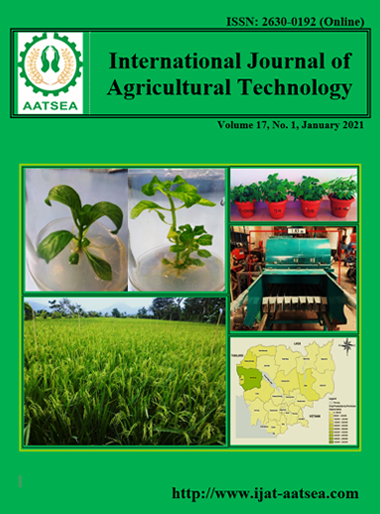The structural model of a sustainable coffee - based agrotechnology parks development in Bengkulu Province, Indonesia
Main Article Content
Abstract
Development of Science and Technology Parks (STP) is included in the Indonesia national development plans targeting 100 units during 2015-2019. Lack of understanding of the concept of technology parks causing the operation is not optimal. The influence of coffee-based agrotechnology parks (ATP) development factors in Kepahiang Regency was investigated. The obtained results by SEM pathways revealed variables with statistically significant effects, i.e., firstly, resource management strategies; secondly, social management strategies; thirdly, cooperation system strategies. These factors had a significant effect on ATP development. Resource management strategies and environmental management strategies had a significant effect on ATP development through cooperation system development. Identification of factors on the development of ATP and the relationship among factors are expected to help planners and decision-makers in strengthening development strategies of coffee agroindustry in the agrotechnology parks
Article Details

This work is licensed under a Creative Commons Attribution-NonCommercial-NoDerivatives 4.0 International License.
References
Albahari, A., Barge-gil, A., Pérez-canto, S. and Modrego, A. (2016). The in fl uence of Science and Technology Park characteristics on fi rms ’ innovation results. Paper in Regional Science, 97:253-279.
Ashton, W. S. (2009). The structure , function , and evolution of a regional industrial ecosystem. Journal of Industrial Ecology, 13:228-246.
Bellini, N., Teräs, J. and Ylinenpää, H. (2012). Science and technology parks in the age of open innovation . The finnish case. Symphonya, 1:25-44.
Bollen, K. A. (2002). Latent variables in psychology and the social sciences. Annual Review of Psychology, 53:605-634.
BPS, [BPS – Statistics Indonesia] (2019). Indonesian Coffee Statistics 2018 (Sub Directorate of Estate Crops Statistics, ed.). Jakarta (ID): BPS – Statistics Indonesia.
Chen, C. and Link, A. N. (2017). Employment in China ’ s hi-tech zones. International Entrepreneurship and Management Journal, 14:697-703.
Díez-vial, I. and Fernández-olmos, M. (2017). Technology Analysis & Strategic Management The effect of science and technology parks on firms ’ performance : how can firms benefit most under economic downturns ? Technology Analysis & Strategic Management ISSN, 29:1153-1166.
Dirjenbun [Direktorat Jendral Perkebunan] (2018). Tree Crop Estate Statistics of Indonesia (D. D. Hendaryati and Y. Arianto, eds.). Jakarta (ID): Secretariate of Directorate General of Estate Crops, Ministry of Agriculture.
Echeverria, M. C. and Nuti, M. (2017). Valorisation of the Residues of Coffee Agro-industry : Perspectives. The Open Waste Management Journal, 10:13-22.
Faria, A. F. De, Ribeiro, J. D. A., Akemi, J. and Sedyama, S. (2019). Success factors and boundary conditions for technology parks in the light of the triple helix model. Journal of Business and Economics, 10:50-67.
Fornell, C. and Larcker, D. F. (1981). Evaluating structural equation models with unobservable variables and measurement error. Journal of Marketing Research, 18:39-50.
Gursel, A. (2014). Science and Technology Parks and University Collaborations. Periodicals Engineering and Naturat Sciences, 2:35-40.
Hair, J. F., Ringle, C. M. and Sarstedt, M. (2011). PLS-SEM: Indeed a silver bullet. Journal of Marketing Theory and Practice, 19:139-151.
Hair, J. F., Sarstedt, M., Ringle, C. M. and Mena, J. A. (2011). An assessment of the use of partial least squares structural equation modeling in marketing research. Journal of the Academy of Marketing Science. https://doi.org/10.1007/s11747-011-0261-6.
Hair, J., Hult, T., Ringle, C. and Sarstedt, M. (2017). A primer on partial least squares structural equation modeling (PLS-SEM) (Second Edi). Thousand Oaks: Sage.
Henseler, J., Ringle, C. M. and Sinkovics, R. R. (2009). The use of partial least squares path modeling in international marketing. Advances in International Marketing, 20:277-319.
Hobbs, K. G., Link, A. N. and Scott, J. T. (2017). The growth of US science and technology parks : does proximity to a university matter ? Annals of Regional Science, 59:495-511.
Hwan, G., Kyu, S. and Un, Y. (2016). Causal relationship of eco-industrial park development factors : a structural equation analysis. Journal of Cleaner Production, 114:180-188.
Kharabsheh, R. (2011). Obstacles of success of technology parks : The case of Jordan. International Journal of Economics and Finance, 3:219-226.
Kharabsheh, R. (2012). Critical Success Factors of Technology Parks in Australia. International Journal of Economics and Finance, 4:57-66.
Muhammad, N. A., Muhyiddin, Faisal, A. and Anindito, I. A. (2017). Pembangunan dan pengembangan STP di Indonesia.pdf. Jurnal Perencanaan Pembangunan, 24:22-43.
Neilson, J., Wright, J. and Aklimawati, L. (2018). Geographical indications and value capture in the Indonesia coffee sector. Journal of Rural Studies, 59:35-48.
Pourfateh, N., Naderi, N. and Rostami, F. (2017). Factors Affecting Commercialization of Agricultural Innovation in Kermanshah Science and Technology Park, Iran. International Journal of Agricultural Management and Development, 7:121-132.
Raithel, S., Sarstedt, M. and Scharf, S. (2011). On the value relevance of customer satisfaction . Multiple drivers and multiple markets. Journal of the Academy of Marketing Science, 40:509-525.
Randriani, E., Penelitian, B. and Industri, T. (2015). Stabilitas Hasil Tiga Klon Kopi Robusta Bengkulu sebagai Klon Unggul Lokal. Jurnal Tanaman Industri Dan Penyegar, 2:159-168.
Ringle, C. M., Da Silva, D. and Bido, D. D. S. (2014). Structural Equation Modeling with the Smartpls. Revista Brasileira de Marketing, 13:56-73.
Sarstedt, M., Ringle, C. M. and Hair, J. F. (2017). Partial Least Squares Structural Equation Modeling. https://doi.org/10.1007/978-3-319-05542-8.
Sun, H., Ni, W. and Leung, J. (2007). Critical success factors for technological incubation : Case study of Hong Kong science and technology parks. International Journal of Management, 24:346-363.
Vellema, W., Casanova, A. B., Gonzalez, C. and Haese, M. D. (2015). The effect of specialty coffee certification on household livelihood strategies and specialisation. Food Policy, 57:13-25.
Weng, X. H., Zhu, Y. M., Song, X. Y. and Ahmad, N. (2019). Identification of key success factors for private science parks established from brownfield regeneration: A case study from China. International Journal of Environmental Research and Public Health 16. https://doi.org/10.3390/ijerph16071295.
Zhang, Y. (2005). The science park phenomenon : development , evolution and typology Yuehua Zhang. International Journal of Entrepreneurship and Innovation Management, 5:138-154.
Zieliński, M., Rogala, A. and Takemura, M. (2014). Business Model of Science and Technology Parks: Comparison of European Best Practice. Meiji University Press, pp. 15-28.


